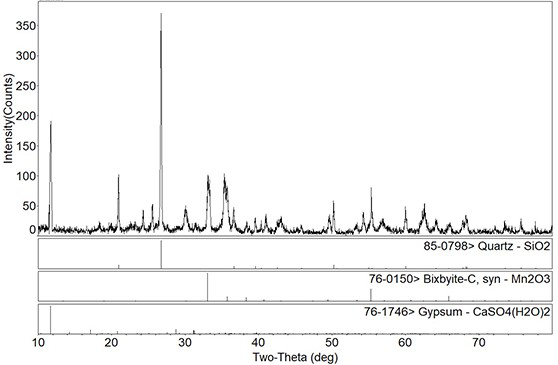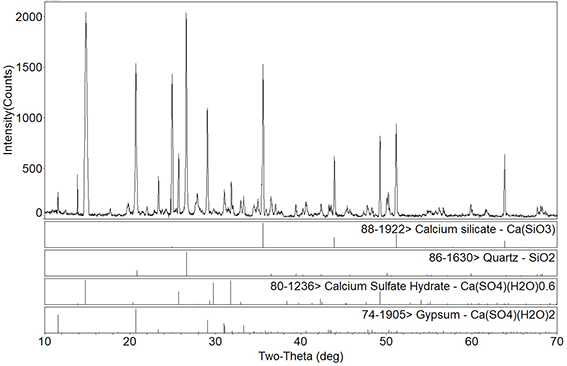Resourceful treatment method for manganese slag and calcium chloride waste residues
A treatment method and technology of calcium chloride, applied in manganese halide, cement production and other directions, can solve the problems of unrealized bulk consumption of solid waste, low chlorination reaction efficiency, unsuitable electrolytic manganese slag, etc.
- Summary
- Abstract
- Description
- Claims
- Application Information
AI Technical Summary
Problems solved by technology
Method used
Image
Examples
Embodiment 1
[0044] Such as figure 1 As shown, in step S1 of this embodiment, 1 ton of manganese slag is weighed, and 200 kg of standard coal pulverized coal is mixed evenly to form a mixture A, and the mixture A is added to a reduction roasting kiln through a screw feeder, and air is introduced into the kiln to raise the temperature to 1200°C and stay in this temperature range for 150min.
[0045] The main components of the manganese slag managed by the present embodiment are calcium sulfate, silicon dioxide and a small amount of manganese trioxide, etc., such as figure 2 As shown in the XRD phase spectrum of the manganese slag, the element content of each component in the manganese slag is shown in Table 1, and the corresponding element content of each component in the manganese slag is expressed by oxides in the table (calcium is expressed by CaO, and sulfur is expressed by SO 3 Form expression, manganese is represented by MnO form).
[0046] Table 1 Main components of electrolytic ...
Embodiment 2
[0055] The present embodiment selects manganese slag and calcium chloride with the same composition as in Embodiment 1.
[0056] Step S1 of this embodiment weighs 1 ton of manganese slag, mixes it into 100 kg of standard coal coal powder and mixes it evenly to form a mixture A, and then puts the mixture A into the reduction roasting kiln through a screw feeder, and the temperature of the kiln is raised to 800° C. And stay in this temperature range for 60 minutes.
[0057] Step S2 takes by weighing 520kg of calcium chloride waste residue with a water content of 20% and 32kg of quartz sand and uniformly mixes it into a mixture B, the mass ratio of calcium chloride in the mixture B to silica in the quartz sand is 2:1, and the reduced The roasted product is directly added to the chlorination roasting kiln, and the mixture B is added to the chlorination roasting kiln at the same time. The mass ratio of the calcium chloride in the mixture B to the manganese monoxide in the reduction...
Embodiment 3
[0062] The present embodiment selects manganese slag and calcium chloride with the same composition as in Embodiment 1.
[0063] Such as figure 1 As shown, in step S1 of this embodiment, 1 ton of manganese slag is weighed, and 150 kg of standard coal pulverized coal is mixed evenly to form a mixture A, and the mixture A is added to a reduction roasting kiln through a screw feeder, and air is introduced into the kiln to raise the temperature to 1000°C and stay in this temperature range for 120min.
[0064] Step S2 takes by weighing 630kg of calcium chloride waste residue with a moisture content of 30% and 50kg of quartz sand and evenly mixes it into a mixture B, the mass ratio of calcium chloride in the mixture B to silica in the quartz sand is 1.5:1, and the reduced The roasted product is directly added to the chlorination roasting kiln, and the mixture B is added to the chlorination roasting kiln at the same time. The mass ratio of the calcium chloride in the mixture B to th...
PUM
 Login to View More
Login to View More Abstract
Description
Claims
Application Information
 Login to View More
Login to View More - R&D
- Intellectual Property
- Life Sciences
- Materials
- Tech Scout
- Unparalleled Data Quality
- Higher Quality Content
- 60% Fewer Hallucinations
Browse by: Latest US Patents, China's latest patents, Technical Efficacy Thesaurus, Application Domain, Technology Topic, Popular Technical Reports.
© 2025 PatSnap. All rights reserved.Legal|Privacy policy|Modern Slavery Act Transparency Statement|Sitemap|About US| Contact US: help@patsnap.com



